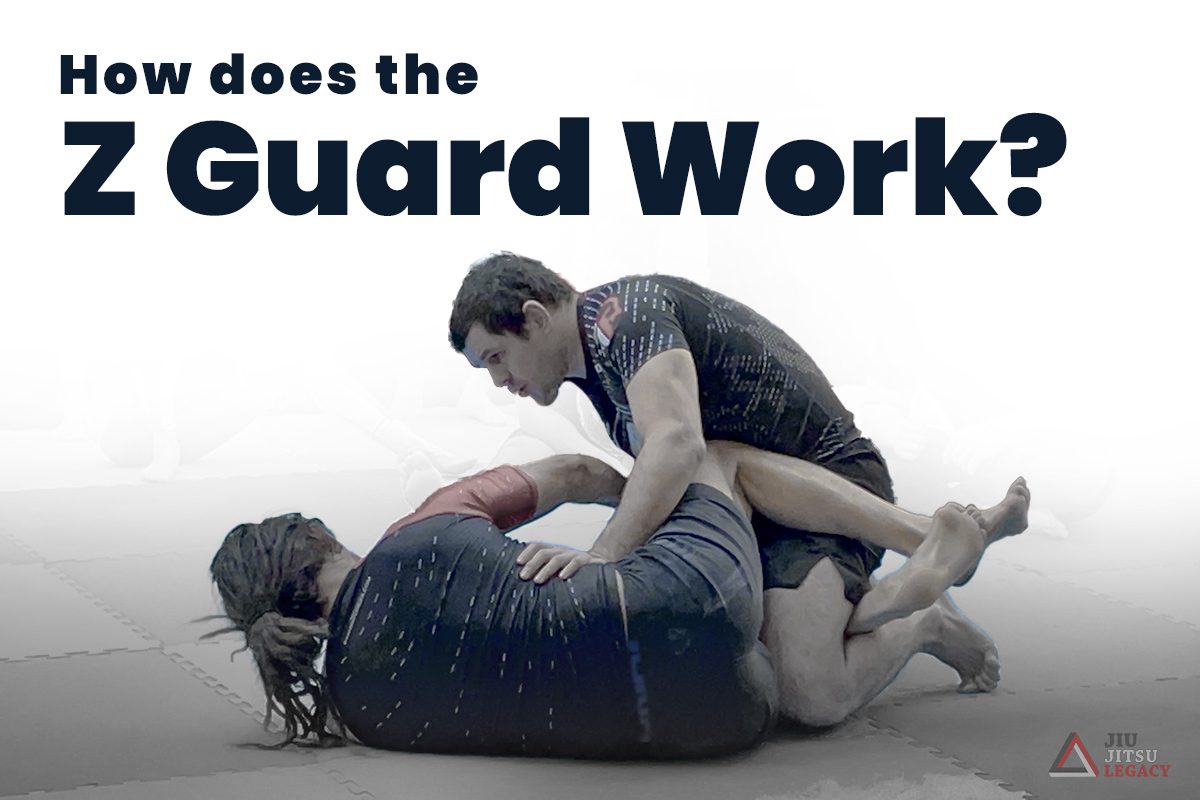The Z Guard is a position that most people will experience early on in their BJJ journey. New people stumble onto it accidentally, and it is widely used across the belt ranks.
Z Guard is one of those positions that people pick up quickly because it comes instinctively, which is quite uncommon with many Jiu Jitsu positions. The fact that this guard is easy to pick up and quite a nuisance to deal with makes it a great guard to add to your game.
Let’s explore this intuitive guard position and see what makes it so effective:
Why is the Z Guard BJJ Position so Popular?
The simple answer is that the BJJ Z guard is popular because it is lazy. It doesn’t require any amount of strength, explosiveness, or flexibility to play, while at the same time you are fairly safe from most attacks. A simple switch of the knee position renders most passing attempts useless while opening up many different sweeps and submissions.
The ease of getting to the Z guard is another reason why people love the guard. There’s no need for elaborate setups when the guard position comes naturally even when you’re under pressure from the top person. The structure of the Z guard itself provides safety in terms of guard retention, and even recovering this guard is easier compared to most other half guard variations.
Also, worth mentioning is that the BJJ Z guard is equally as effective at both keeping aggressive opponents at bay and forcing defensive opponents to engage.
General Theory of the BJJ Z Guard

The Z Guard, also known as knee shield, is a half guard variation that involves placing your shin across the opponent’s belly or chest, preventing them from advancing towards you. It works in both gi and no-gi BJJ and works against grapplers of all belt levels.
The key concept to remember is that whenever you’re playing half guard, you should not be lying down with both your shoulder blades to the mats. This means that the starting position for the BJJ Z guard has you lying on your side, keeping one shoulder off the mats at all times.
This body position not only ensures you can play guard without getting smashed but also helps you define a top and bottom leg and arm, which is very important.
It is your top leg that plays the role of the shield, placed in a Z-like configuration with your shin across your opponent’s torso. It can be placed anywhere from horizontally across the belly, to diagonally across their chest.
The placement of the top leg allows you to control distance, create Kuzushi (disrupt balance), and force or prevent opponents from engaging you, all the while wasting next to no energy.
This top leg works in unison with the top arm, helping you protect the space in between your knee and shoulder (your inside space). As long as you have your top arm’s elbow connected to your torso or your top leg, the guard passer won’t be able to get the underhook control which they need to pass.
Your bottom leg defines how mobile you will be, depending on how deep your knee is placed in between the opponent’s legs. The deeper your knee is, the less mobile you will be, so you should aim to place the knee near the opponent’s knee line.
The bottom arm is tasked with protecting your head. One way to do so is to make sure it blocks your opponent’s far arm at the biceps. A lazier (and more defensive) way is to put the elbow to the ground, placing your palm on your forehead. This, in combination with the knee shield, makes it almost impossible for the guard passer to crossface you.
Z Guard BJJ Attacks
The hierarchy of guard checkpoints is true for the BJJ Z Guard as it is for all other guards. First of all, make sure you control your opponent so that they don’t threaten with passes. Next, disrupt their balance, opening up both sweep and submission opportunities. If you can’t manage to finish your attacks, you can also use the Z guard to switch to other half guard variations.
Controlling the Z Guard
From the typical Z guard position (shin across and elbow tight on top leg and arm, shallow knee, and protecting your head with the bottom arm) you can control the position only if you can keep every limb in position.
Reaching with your arms for collar grips is inadvisable – it will weaken the strong guard configuration you have. Instead, use the knee shield to off-balance your opponent, making them reach so that you can achieve your attacking avenues.
Whenever your opponent tries to move a limb out of position (which will mostly happen with the knee shield leg) you simply pummel or sneak it back through. In the case of the top leg, you might change the position of the shin to switch control from forcing distance (across the chest) to actively threatening their balance (across the belly).
Z Guard Sweeps
John Wayne Sweep from Z Guard
One easy sweep to use from Z Guard is the John Wayne sweep. Whenever opponents decide to try and circle around your top leg’s knee, they will place all their weight on the leg that is between your top and bottom leg. This means that a simple bridging motion that takes your knees from pointing in one direction to the other will sweep your opponent effortlessly.
Rainbow Sweep from Z Guard
Another sweep I like is the Rainbow sweep. It involves gi grips on the opponent’s free leg and same side arm, but can also be modified for no-gi. The idea is to isolate both limbs on one side, before taking the arm over your own head in a big circle, so that your opponent’s torso ends up perpendicular to you.
This will allow you to sweep them over your head by bringing your knees to your chest and extending the knee shield leg as you roll over your head into top position.
Submissions From the BJJ Z Guard
Armbar From Z Guard
The main submission attacks available from the BJJ Z guard are upper body attacks, in the form of arm locks and chokes.
If your opponent manages to sneak a crossface through, there is a very sneaky straight armlock you can do. The first step is to trap their arm at shoulder level with both your arms (palm to palm grip) before throwing the leg that you used as a knee shield over the back of their head.
This effectively takes you out of the guard, but as long as you place the shin of the leg you swung into their armpit, you’ll both have a secure position and a tight arm lock finish.
Triangle From Z Guard
The triangle choke is a powerful finishing option from the Z guard. In order to set it up you will need to establish an overhook control over the opponent’s arm with your top arm.
Since they are going to be hunting for underhooks on that side it is easy to bait them in. You should aim to control their other arm with your bottom arm at wrist level, making enough space to sneak out the bottom leg in order to throw it over their shoulder for a triangle. Having a shallow knee on the bottom leg is extremely important in this case.
Passing The BJJ Z Guard
While it may be pretty difficult, there is a way past the BJJ Z guard, In fact, there’s more than one. With all of the Z guard passes, the common thread is that you have to beat the knee shield leg before thinking about passing. That means deconstructing the guard, which you can achieve by manipulating your opponent’s knee, bringing them together or separating them.
Here are six different passes based on the premise of controlling the knees:
In Summary
The BJJ Z Guard is a highly reliable and easy-to-understand guard. It works in both gi and no-gi and can help a lower-level grappler frustrate higher belts when done right.
The guard offers different attacks and easy retention, all the while helping you bait people into engaging or keeping them at a safe distance. Even if you’re not a fan of the guard you need to spend some time playing it in order to figure out how to best get past it when others inevitably use it against you.

Ogi is a black belt that does Jiu Jitsu full time and is very passionate about anything grappling-related.
He is also the head coach of Enso Jiu Jitsu in Macedonia and an aspiring Globetrotter.

